

St
Mark Whitechapel (Goodman’s Fields) 1839-1925
also known as St Mark, Tenter Ground curates ~ baptism & wedding statistics
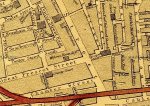
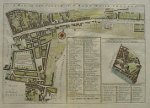 For the earlier history of Goodman's Fields see here.
The 1755 map [left], from an
edition of John Stow's Survey
of the Cities of London and Westminster,
shows the area as the southern part of the parish of St Mary Matfelon,
the original 'White Chapel' which gave the district its name. (That
church was rebuilt several times, blitzed in the war and its site is
now Altab Ali Park; much has been written about its history). By the
mid-19th century houses had been built around the edge of Tenter
Ground, as
North, South, East and West Tenter Streets (a few of
which remain) and
it was bisected by what became Scarborough and St Mark's Streets. It had become a poor and populous district, and the
decision was made to create a new parish. The 1868 map right, shows
the location of the church; further south, the school hemmed in by the
railway, and to
the east, on Backchurch Lane, the mission chapel mentioned below.
For the earlier history of Goodman's Fields see here.
The 1755 map [left], from an
edition of John Stow's Survey
of the Cities of London and Westminster,
shows the area as the southern part of the parish of St Mary Matfelon,
the original 'White Chapel' which gave the district its name. (That
church was rebuilt several times, blitzed in the war and its site is
now Altab Ali Park; much has been written about its history). By the
mid-19th century houses had been built around the edge of Tenter
Ground, as
North, South, East and West Tenter Streets (a few of
which remain) and
it was bisected by what became Scarborough and St Mark's Streets. It had become a poor and populous district, and the
decision was made to create a new parish. The 1868 map right, shows
the location of the church; further south, the school hemmed in by the
railway, and to
the east, on Backchurch Lane, the mission chapel mentioned below.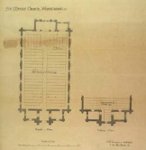
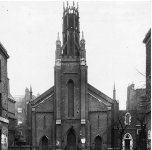 Under
a faculty of 23 September 1874 William Alexander
Longmore of Aldgate removed the
north and south galleries to throw open the roof, rebuilt the east wall
six feet further east to allow a chancel to
be formed, partially reseated the church and did various repairs; the
Incorporated Church Building Society made a grant (see
their plan 07698, drawn by another architect, G.H. Simmons). In 1879 the organ,
a 17-stop 2 manual instrument by Gray and Davison,
ordered in 1839 and installed in 1846, was moved from the west
gallery
and rebuilt in the old vestry at the north-east by T.R. Willis. (It was
further rebuilt by Robert Slater & Son of Forest Gate in 1904 or
1906, with 20 speaking stops. The organist in the 1920s was Charles F.
Willson. When the church
closed, the organ was moved to St James Alperton, but was later
replaced by
another instrument). Two years later the
interior was brightened by some wall paintings.The exterior is pictured
right in the 1920s.
Under
a faculty of 23 September 1874 William Alexander
Longmore of Aldgate removed the
north and south galleries to throw open the roof, rebuilt the east wall
six feet further east to allow a chancel to
be formed, partially reseated the church and did various repairs; the
Incorporated Church Building Society made a grant (see
their plan 07698, drawn by another architect, G.H. Simmons). In 1879 the organ,
a 17-stop 2 manual instrument by Gray and Davison,
ordered in 1839 and installed in 1846, was moved from the west
gallery
and rebuilt in the old vestry at the north-east by T.R. Willis. (It was
further rebuilt by Robert Slater & Son of Forest Gate in 1904 or
1906, with 20 speaking stops. The organist in the 1920s was Charles F.
Willson. When the church
closed, the organ was moved to St James Alperton, but was later
replaced by
another instrument). Two years later the
interior was brightened by some wall paintings.The exterior is pictured
right in the 1920s.| Sundays
11am & 6.30pm; weekdays (except Saturday) and holy days 11am, plus
Wednesdays at 1pm; HC first Sunday and greater festivals |
…AND ITS CLERGY
| We held a meeting of influential inhabitants yesterday, and formed a committee of ten gentlemen, with hope of adding to their number. Sixteen other persons volunteered to act as visitors, and I doubt not, in a little while, considerably to increase the number, as we all were encouraged by your kind promise of pecuniary aid to relieve the vast amount of distress which naturally prevails in such localities as mine; and I now find that a want of means to relieve the misery to be encountered was the circumstance which kept many of my people from the work of district visiting, That objection will now be obviated by the assistance of your society. |


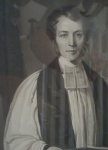 John
Lyons (1847-52), was born in
Ireland in 1804 and ordained there. Briefly minister of Long Acre
Chapel
in London (where he was active in the Irish Society of London) and from
1833-38 of All Saints Chapel, Grosvenor Street in Liverpool (created
from a former tennis court in 1798, licensed by the Bishop of Chester
in 1832 - and sold to the Roman Catholics in 1845), he was involved in
various Protestant associations, and debates with Roman
Catholics, including this
marathon six day session, harmoniously conducted, on 'The Rule of
Faith' and 'The Sacrifice of the Mass' at Downside College, Bath in
1834 [title page right].
After his time in Bolton, and his exchange with Neville
Jones, he became vicar of Tillingham in Essex (eliciting a pious ode on
his departure - right - published
in John Osborne A Poetic
Miscellany 1866), then in 1859 of
St Bartholomew Wednesbury, where there is a memorial marking his death
in 1883.
John
Lyons (1847-52), was born in
Ireland in 1804 and ordained there. Briefly minister of Long Acre
Chapel
in London (where he was active in the Irish Society of London) and from
1833-38 of All Saints Chapel, Grosvenor Street in Liverpool (created
from a former tennis court in 1798, licensed by the Bishop of Chester
in 1832 - and sold to the Roman Catholics in 1845), he was involved in
various Protestant associations, and debates with Roman
Catholics, including this
marathon six day session, harmoniously conducted, on 'The Rule of
Faith' and 'The Sacrifice of the Mass' at Downside College, Bath in
1834 [title page right].
After his time in Bolton, and his exchange with Neville
Jones, he became vicar of Tillingham in Essex (eliciting a pious ode on
his departure - right - published
in John Osborne A Poetic
Miscellany 1866), then in 1859 of
St Bartholomew Wednesbury, where there is a memorial marking his death
in 1883.  A 'Rev J. Lyons' wrote this poem [left] in The Ladies' Repository
of
1849; if it was not him, it's worth including anyway as a pious
response to new technology! [Compare the famous example of bathos by
the Poet Laureate Alfred Austin, fifty years later on the illness of
the Prince of Wales: Across the
wires the electric message came: 'He is no better. He is much the same.']
A 'Rev J. Lyons' wrote this poem [left] in The Ladies' Repository
of
1849; if it was not him, it's worth including anyway as a pious
response to new technology! [Compare the famous example of bathos by
the Poet Laureate Alfred Austin, fifty years later on the illness of
the Prince of Wales: Across the
wires the electric message came: 'He is no better. He is much the same.']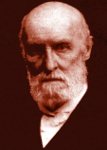
 Then
came John Llewellyn Davies
(1852-56), born
1826, a
Fellow of Trinity College Cambridge, who came to St Mark's after a
year's unpaid curacy at St Anne Limehouse. He was a Broad Churchman and
lifelong friend and disciple
of F.D.
Maurice (as were several of his successors), working with him on
the establishment of the foundation of the Working
Men's College in 1854. A
frequent letter-writer to The
Times and The
Guardian he corresponded with many
leading liberal figures of the day - you can read some of their
replies, edited by his son as A Victorian Postbag. This appeal [right] from
The Evangelical Magazine
vol 32 (154) shows his willingness to work ecumenically.
(See here for his
friend and unpaid curate Robert Hebert Quick.)
Then
came John Llewellyn Davies
(1852-56), born
1826, a
Fellow of Trinity College Cambridge, who came to St Mark's after a
year's unpaid curacy at St Anne Limehouse. He was a Broad Churchman and
lifelong friend and disciple
of F.D.
Maurice (as were several of his successors), working with him on
the establishment of the foundation of the Working
Men's College in 1854. A
frequent letter-writer to The
Times and The
Guardian he corresponded with many
leading liberal figures of the day - you can read some of their
replies, edited by his son as A Victorian Postbag. This appeal [right] from
The Evangelical Magazine
vol 32 (154) shows his willingness to work ecumenically.
(See here for his
friend and unpaid curate Robert Hebert Quick.)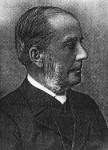 David
James
Vaughan
(1856-60) was Davies' exact contemporary (and joint Bell's Scholar) at
Trinity, and
in 1852 they produced together a translation with scholarly
notes of
Plato's Republic,
the most widely-used version until eclipsed by that of Benjam
Jowett, and still well-regarded.
Influenced by Maurice, Ludlow and Campbell
(who dedicated his Evidences to
Vaughan)
he had moved from Tractarianism to a liberal, broad church position
which embraced the emerging Christian Socialism. He joined the Society
for the Encouragement of Arts, Manufacture and Commerce in 1853. At
Rugby School and
Cambridge he had become 'surrogate brother' to T.H. Green, the
philosopher of social justice. After his time at St Mark's, he became
the third of his High Tory father
Edward Thomas Vaughan's (1777-1829) six
sons - there were also eight daughters - to succeed him as vicar of St
Martin Leicester (now the Cathedral),
following Charles John (1841-44) and
Edward Thomas Jnr
(1845-59). He spent the whole of his
ministry there - turning down the living of Battersea although it was
worth
£1200 a year, as against his Leicester stipend of
£140. The Vaughan porch to the cathedral's south door (designed by J.L.
Pearson) was a memorial to the brothers and their father, and
especially to David's
adult education work.
David
James
Vaughan
(1856-60) was Davies' exact contemporary (and joint Bell's Scholar) at
Trinity, and
in 1852 they produced together a translation with scholarly
notes of
Plato's Republic,
the most widely-used version until eclipsed by that of Benjam
Jowett, and still well-regarded.
Influenced by Maurice, Ludlow and Campbell
(who dedicated his Evidences to
Vaughan)
he had moved from Tractarianism to a liberal, broad church position
which embraced the emerging Christian Socialism. He joined the Society
for the Encouragement of Arts, Manufacture and Commerce in 1853. At
Rugby School and
Cambridge he had become 'surrogate brother' to T.H. Green, the
philosopher of social justice. After his time at St Mark's, he became
the third of his High Tory father
Edward Thomas Vaughan's (1777-1829) six
sons - there were also eight daughters - to succeed him as vicar of St
Martin Leicester (now the Cathedral),
following Charles John (1841-44) and
Edward Thomas Jnr
(1845-59). He spent the whole of his
ministry there - turning down the living of Battersea although it was
worth
£1200 a year, as against his Leicester stipend of
£140. The Vaughan porch to the cathedral's south door (designed by J.L.
Pearson) was a memorial to the brothers and their father, and
especially to David's
adult education work.
 [His brother Charles John
Vaughan,
also a product of Thomas Arnold's Rugby School, was appointed
Headmaster of Harrow in 1845 where he sought to achieve a similar
programme of public school reform, and pointed several hundred young
men (his 'doves') towards ordination - eighteen of them became bishops,
and two archbishops. Highly regarded as a preacher, and by such as
Benson, Davidson, Westcott and Jowett, he left Harrow after firteen
years (as he claimed had always been his plan), returning to Leicester
before becoming Vicar of Doncaster, and then (in plurality) Master of
the Temple and Dean of Llandaff, and also Deputy Clerk of the Closet to
maintain his connections with Queen Victoria. Why he did not
himself become a bishop remains a matter of some pseculation. In 1964
Phyllis Grosskurth claimed it was because of a
well-concealed sexual scandal:
misconduct with a pupil, Alfred Pretor, who revealed this in a letter
to fellow-pupil John
Addington Symonds.
Symonds, though by then part of the Oxford homosexual 'network' (he
later married and had children. but remained a writer and commentator
on 'male love', as well as an enthusiast for Italian travel - see here
for a tribute after his
death by the local county court judge A.R. Cluer) was encouraged to
tell his father, who is it said prevented Vaughan's appointment as
Bishop of Rochester. (Pretor never spoke to Symonds again.) But Canon
Trevor Park, who has published Vaughan's 300 surviving letters (out of
an estimated total of 300,000 - the rest were burnt at his request)
claims, in Nolo
Episcopari: A Life of C.J. Vaughan
(St Bega Press 2014) that, although there were certainly 'romantic
friendships' with pupils past and present (Vaughan was married, but
childless), there is no clear evidence of misconduct, and that he
declined episcopal offers because of his understanding of vocation
rather than because of the threat of exposure.]
[His brother Charles John
Vaughan,
also a product of Thomas Arnold's Rugby School, was appointed
Headmaster of Harrow in 1845 where he sought to achieve a similar
programme of public school reform, and pointed several hundred young
men (his 'doves') towards ordination - eighteen of them became bishops,
and two archbishops. Highly regarded as a preacher, and by such as
Benson, Davidson, Westcott and Jowett, he left Harrow after firteen
years (as he claimed had always been his plan), returning to Leicester
before becoming Vicar of Doncaster, and then (in plurality) Master of
the Temple and Dean of Llandaff, and also Deputy Clerk of the Closet to
maintain his connections with Queen Victoria. Why he did not
himself become a bishop remains a matter of some pseculation. In 1964
Phyllis Grosskurth claimed it was because of a
well-concealed sexual scandal:
misconduct with a pupil, Alfred Pretor, who revealed this in a letter
to fellow-pupil John
Addington Symonds.
Symonds, though by then part of the Oxford homosexual 'network' (he
later married and had children. but remained a writer and commentator
on 'male love', as well as an enthusiast for Italian travel - see here
for a tribute after his
death by the local county court judge A.R. Cluer) was encouraged to
tell his father, who is it said prevented Vaughan's appointment as
Bishop of Rochester. (Pretor never spoke to Symonds again.) But Canon
Trevor Park, who has published Vaughan's 300 surviving letters (out of
an estimated total of 300,000 - the rest were burnt at his request)
claims, in Nolo
Episcopari: A Life of C.J. Vaughan
(St Bega Press 2014) that, although there were certainly 'romantic
friendships' with pupils past and present (Vaughan was married, but
childless), there is no clear evidence of misconduct, and that he
declined episcopal offers because of his understanding of vocation
rather than because of the threat of exposure.]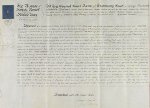 Robert
Edward Bartlett
(1860-66 - Vicar from 1863) was a student at Rugby under Dr Arnold, and
at Balliol, then Trinity College Oxford where he became Fellow and
Tutor prior to his
appointment here. (He had been President of the Oxford Union, and years
later commented on a debate in which W.E. Gladstone, future Prime
Minister, had spoken for a particular motion but then voted against
it.) The family home was at Rainsford Lodge, in the centre
of Chelmsford; while still a student, he was involved in the
development of the Chelmer
& Blackwall Navigation Company [see this 1852 deed, left]. Throughout
his life he corresponded with leading figures of the liberal world -
among them E.A. Freeman, a Trinity contemporary who became Regius
Professor of Modern History - see examples here.
Three children were born at the parsonage in Goodman's Fields -
William, who became a priest, Frank who became a civil servant in
Ceylon, and Grace (one of the first women to study at Oxford). See here
for the evidence he gave in 1862 to the Select Committee on the
Ecclesiastical Commission, on the funding of poor parishes.
Robert
Edward Bartlett
(1860-66 - Vicar from 1863) was a student at Rugby under Dr Arnold, and
at Balliol, then Trinity College Oxford where he became Fellow and
Tutor prior to his
appointment here. (He had been President of the Oxford Union, and years
later commented on a debate in which W.E. Gladstone, future Prime
Minister, had spoken for a particular motion but then voted against
it.) The family home was at Rainsford Lodge, in the centre
of Chelmsford; while still a student, he was involved in the
development of the Chelmer
& Blackwall Navigation Company [see this 1852 deed, left]. Throughout
his life he corresponded with leading figures of the liberal world -
among them E.A. Freeman, a Trinity contemporary who became Regius
Professor of Modern History - see examples here.
Three children were born at the parsonage in Goodman's Fields -
William, who became a priest, Frank who became a civil servant in
Ceylon, and Grace (one of the first women to study at Oxford). See here
for the evidence he gave in 1862 to the Select Committee on the
Ecclesiastical Commission, on the funding of poor parishes.  Bartlett
was the Bampton
Lecturer
in 1888: his eight philosophical lectures on St Paul were published
as The Letter and the Spirit [right]. In 1893 he was one of ten
contributors to a series of lecture-sermons Christus
Imperator, on
the 'Universal Empire of Christianity', edited by Charles Stubbs,
Dean-designate of Ely (Macmillan 1984), his topic being 'Christ in the
Realm of Philosophy'. (Fellow-contributors included Llewelyn Davies [above] on 'Christ in the Realm of
Ethics', Brooke Lambert on
'Christ in the Realm of Science', Samuel Barnett
- by then Warden of Toynbee Hall - on 'Christ in the Realm of
Sociology' and Canon Rawnsley, founder of the National Trust, on
'Christ in the Realm of Art'.) There were other publications, including
an article on 'The Limits of Ritual in the Church of England'
(Contemporary Review
1890), and chapters on 'The Holy Catholic Church' in
ed. Henry Wace and F.W. Farrar Church and Faith
(Blackwood 1899) and on 'The Relations of the Church of England with
Modern Nonconformity' from the 1899 Christian
Conference
of the Church Congress (A & C Black 1900) - a body established in
1881 which included fellow-liberals such as Brooke Lambert and Harry Jones.
Bartlett
was the Bampton
Lecturer
in 1888: his eight philosophical lectures on St Paul were published
as The Letter and the Spirit [right]. In 1893 he was one of ten
contributors to a series of lecture-sermons Christus
Imperator, on
the 'Universal Empire of Christianity', edited by Charles Stubbs,
Dean-designate of Ely (Macmillan 1984), his topic being 'Christ in the
Realm of Philosophy'. (Fellow-contributors included Llewelyn Davies [above] on 'Christ in the Realm of
Ethics', Brooke Lambert on
'Christ in the Realm of Science', Samuel Barnett
- by then Warden of Toynbee Hall - on 'Christ in the Realm of
Sociology' and Canon Rawnsley, founder of the National Trust, on
'Christ in the Realm of Art'.) There were other publications, including
an article on 'The Limits of Ritual in the Church of England'
(Contemporary Review
1890), and chapters on 'The Holy Catholic Church' in
ed. Henry Wace and F.W. Farrar Church and Faith
(Blackwood 1899) and on 'The Relations of the Church of England with
Modern Nonconformity' from the 1899 Christian
Conference
of the Church Congress (A & C Black 1900) - a body established in
1881 which included fellow-liberals such as Brooke Lambert and Harry Jones.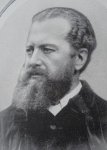 Brooke
Lambert (curate 1864, Vicar 1865-71) - right - was born in 1834 into a titled family of Huguenot origins - Sir John Lambert, the first baronet (d.1723) had come from the Ile de
Rhé and settled as a merchant in London
soon after 1685. He was the fourth son (and fifth of eight children) of
Francis John Lambert, son of the fourth baronet; his Welsh mother was
the daughter of a Peninsular officer. The family lived in Kensington.
After home schooling, and a time at a school run by James Chase, an
evangelical clergyman, he went to Brighton College in 1849, and from
there to King's College London to study for ordination. He became a
lifelong 'disciple' of F.D. Maurice
who was ejected from his King's professorship in 1853. From there he
went to Brasenose College, Oxford, as a commoner, choosing a pass
degree to enable him to pursue his own programme (which included
Stanley's lectures on ecclesiastical history); he graduated in 1858 (MA
1861 and Bachelor of Common Law 1863), and was ordained that year to a
title at Christ Church Preston, moving in 1860 to St John Worcester.
After some months at Hillingdon, near Uxbridge, he offered himself as
Bartlett’s curate, and on his departure became Vicar (1866-71) - the
year when a cholera outbreak hit the area and, as elsewhere (notably St Peter London Docks), clergy performed heroic service. He circulated
parish directions, organised the distribution of medicine and visited
the sick assiduously; on one day he buried forty-four
corpses.
Brooke
Lambert (curate 1864, Vicar 1865-71) - right - was born in 1834 into a titled family of Huguenot origins - Sir John Lambert, the first baronet (d.1723) had come from the Ile de
Rhé and settled as a merchant in London
soon after 1685. He was the fourth son (and fifth of eight children) of
Francis John Lambert, son of the fourth baronet; his Welsh mother was
the daughter of a Peninsular officer. The family lived in Kensington.
After home schooling, and a time at a school run by James Chase, an
evangelical clergyman, he went to Brighton College in 1849, and from
there to King's College London to study for ordination. He became a
lifelong 'disciple' of F.D. Maurice
who was ejected from his King's professorship in 1853. From there he
went to Brasenose College, Oxford, as a commoner, choosing a pass
degree to enable him to pursue his own programme (which included
Stanley's lectures on ecclesiastical history); he graduated in 1858 (MA
1861 and Bachelor of Common Law 1863), and was ordained that year to a
title at Christ Church Preston, moving in 1860 to St John Worcester.
After some months at Hillingdon, near Uxbridge, he offered himself as
Bartlett’s curate, and on his departure became Vicar (1866-71) - the
year when a cholera outbreak hit the area and, as elsewhere (notably St Peter London Docks), clergy performed heroic service. He circulated
parish directions, organised the distribution of medicine and visited
the sick assiduously; on one day he buried forty-four
corpses.| It
is impossible for any but those who live and work near here to
understand all the suffering which the Whitechapel and Aldgate
slaughter-houses entail. To reach these houses the cattle have to be
driven along a street crowded with trams, omnibuses, and general
traffic. The drivers are almost of necessity cruel, as they hasten the
brutes through such a thoroughfare; the animals, excited by shouts and
blows, frequently make frantic rushes, and endanger the lives of the
foot-passengers. From these slaughter-houses, too, the blood flows
across the pavement, and there arises a close smell which seems to
thicken the air and make breathing a pain .... We know that life here
is not vigorous; the air has no refreshing power; and we are well able
to understand why so many resort to drink. Dr. Liddle, our medical
officer, has spoken and written strongly on the harm done to the health
of our neighbourhood by means of these houses. The medical officers of
the Health Association have, I think, agreed unanimously on the
injurious effect of the trade. Those who crowd our courts, the passers
through our streets, the little children who see the cruelty, the
cattle who suffer, all want a voice to tell their needs. It is out of
my power to do more than ask your help. By your means the House of
Lords may learn the meaning of an Act which establishes
slaughter-houses in the City. I trust we may not have a law directly
injurious to health passed by a Government whose motto is sanitas sanitatum. |
| If
any one wishes to know
whether the
nuisance be real, let him turn out of the Whitechapel Road at the
entrance to the London and North-Western goods station, and pass down
the streets leading thence to Mansell Street. He will then know what
the smell of blood is. And yet he will probably often boldly encounter
the smell of blood in preference to the worse sights he will risk in
Whitechapel Road. The carts laden with fresh skins, the pails full of
blood and brains, are sights to which a long experience does not harden
one. Anna Bonus Kingsford The Perfect Way in Diet, chapter 8 – a Vegetarian Society publication that went through several editions |
FINAL DAYS
 In
the early part of the 20th century, extreme deprivation and poverty
continued, and
the church struggled to survive. The congregation continued to dwindle,
and missionary work among the Jews came to nothing. After the
First
World War the decision was made to close the
church. The school,
however, despite various difficulties, and a petition for closure in
1921, remained open until the Second World War.
In
the early part of the 20th century, extreme deprivation and poverty
continued, and
the church struggled to survive. The congregation continued to dwindle,
and missionary work among the Jews came to nothing. After the
First
World War the decision was made to close the
church. The school,
however, despite various difficulties, and a petition for closure in
1921, remained open until the Second World War. 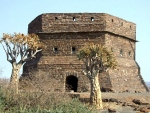 Ernest
James Crosby became
Curate-in-charge from 1922-26 (when the church closed), and Curate of
the united parish (with St
Paul Dock Street) from 1926-28 - no doubt a depressing 'closure'
ministry. He had
previously served in Norfolk, Kent and Cornwall and as a chaplain in
the First World War. He went on to become
Rector of Prieska in the northern Cape Province - then a remote farming
area (its name means 'place of the lost goat') at a ford crossing the
Orange River, which had featured in the
Boer War - the fort, decorated with locally-mined semi-precious stones
including tiger's-eye, survives [pictured].
More recently copper, zinc and
asbestos were mined there.
Ernest
James Crosby became
Curate-in-charge from 1922-26 (when the church closed), and Curate of
the united parish (with St
Paul Dock Street) from 1926-28 - no doubt a depressing 'closure'
ministry. He had
previously served in Norfolk, Kent and Cornwall and as a chaplain in
the First World War. He went on to become
Rector of Prieska in the northern Cape Province - then a remote farming
area (its name means 'place of the lost goat') at a ford crossing the
Orange River, which had featured in the
Boer War - the fort, decorated with locally-mined semi-precious stones
including tiger's-eye, survives [pictured].
More recently copper, zinc and
asbestos were mined there. A
memorial to 29 men from St Mark's parish who were killed in the First
World War - a ceramic crucifixion, with wooden shutters listing the
names -
was
transferred to St George-in-the-East (via St Paul Dock Street) but was
stolen a few years later in 1991; it has not been recovered [better
picture needed].
A
memorial to 29 men from St Mark's parish who were killed in the First
World War - a ceramic crucifixion, with wooden shutters listing the
names -
was
transferred to St George-in-the-East (via St Paul Dock Street) but was
stolen a few years later in 1991; it has not been recovered [better
picture needed].